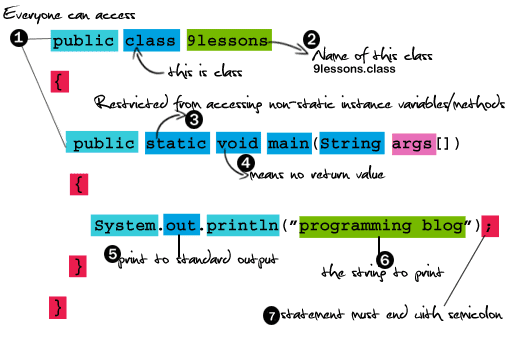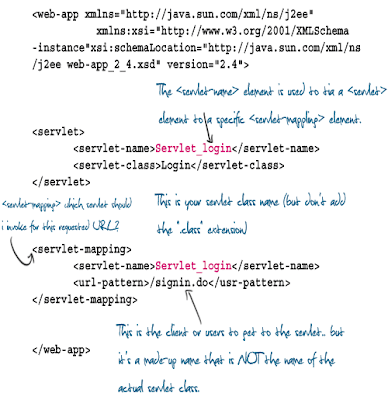
JAVAC.EXE
"javac" is the standard compiler in JDK.
"-sourcepath" specifies places where to search for source definitions of new types.
"-classpath" specifies places where to search for class definitions of new types.
Two types of "import" statements behave differently with "javac".
Never distribute your class files with debugging information in them.
>javac 9lesson.java
JAVA.EXE
"java" is the standard application launcher in JDK.
"-sourcepath" specifies places where to search for class definitions of new types.
"-jar" specifies a JAR file and launches the class specified in the manifest file.
"javaw" is identical to "java" except that it will not create the console window.
>java 9lesson
JDB.EXE
"jdb" is a nice debugging tool. But it only offers a command line interface, not so easy to use. It is much more efficient to use graphical interface debugger.
JPDA is well designed, allowing us to debug Java applications remotely.
Debugging multi-thread application is tricky. The following "jdb" notes may help you.
Whenever one thread reaches a break point, all other threads are stopped also.
The command prompt tells what is the current thread.
"where all" tells where the execution are currently in all threads.
"threads" lists all the threads with thread indexes as Hex numbers.
>jdb 9lesson
JAR.EXE
JAR files are ZIP files.
JAR files can have attributes stored in the META-INF/MANIFEST.MF file.
JAR files can be used in Java class paths.
JAR files can be "executable".
>jar xf src.jar
JAVAP.EXE
Used to get back the discription of bitecode:
Eg. If you deleted original source file (9lesson.java). You have only 9lesson.class file
>javap 9lesson
JAVADOC.EXE
Used to create Html file for webpage. 9lesson.java to 9lesson.html
>javadoc 9lesson.java
JVISUALVM.EXE
VisualVM is a visual tool integrating several commandline JDK tools and lightweight profiling capabilities. Designed for both production and development time use, it further enhances the capability of monitoring and performance analysis for the Java SE platform.

JRUNSCRIPT.EXE
Using jrunscript to test regular expressions
>jrunscript.exe
js> "!if:companyname[a!=b]".split(":")[0]
!if
js> "abcdef".match(/bc/)[0];
bc
js>
JAVA-RMI.EXE
If java-rmi.exe is running on your PC, you should verify that it is authentic. A file name alone is insufficient for identification. Run ProgramChecker Personal Edition and FileAnalyzer to be sure you are running the actual version.
JCONSOLE.EXE
jconsole is a GUI tool that allows you to monitor a local or remote JVM process using the JMX (Java Management Extension) technology.
JVM processes must be launched with the default JMX properties turned on in order to be connected by jconsole.
jconsole displays monitoring diagrams for heap memory usage, counts on loaded classes, counts on threads, and CPU usages.
KEYTOOL.EXE
A key entry in keystore contains a private key and a certificate of the public key.
Certificates can be exported into certificate files out of keystore.
Certificates can be imported from certificate back into keystore.
There seems be to no way to export private keys.
There seems be to no way to generate a certificate of a given public key - signing a public key.
native2ascii.exe
"native2ascii": A command line tool that reads a text file stored in a non-ASCII encoding and converts it to an ASCII text file. All non-ASCII characters will be converted into \udddd sequences, where dddd is the Unicode code value of the non-ASCII character.
"native2ascii" is an important Java tool, because Java compiler and other Java tools can only process files which contain ASCII characters and \udddd Unicode code sequences. If you have any non-ASCII character strings written in a native encoding included in your Java source code, you need to run this "native2ascii" tool to convert your Java source code.
"native2ascii" has the following command syntax:
native2ascii [options] inputfile outputfile
JSTAT.EXE
JDK 1.6 offers 3 nice JVM monitoring tools: jps, jstatd, and jstat.
jps is simple tool that allows you to list all running JVM processes on the local machine or a remote machine.
jstatd is an RMI server that allows you to access local JVM processes by jps and jstat from remote machines.
jstat is a monitoring tool that allows you to obtain sample data periodically from a local or remote JVM process.
APPLETVIEWER.EXE
We talked about how a web browser uses the applet tag to resolve and load an applet from a web server to the browsers JVM. Also, during class we commented that for development purposes, reasons for creating an extra source file. If the Appletviewer is a tool used during development, and if all that it does is scan the HTML file for the applet tag, why not include the applet tag within the Java source file as part of your program documentation.
/*
<APPLET CODE="HelloWorld.class" WIDTH=300 HEIGHT=300>
</APPLET>
*/
>appletviewer HelloWorld.java
Post your information. Please comment























